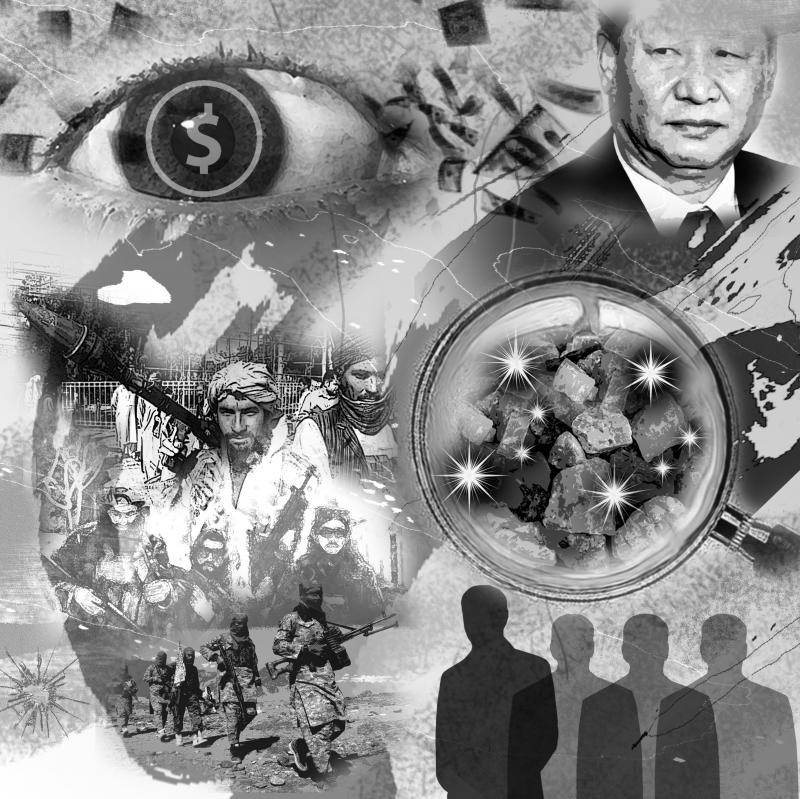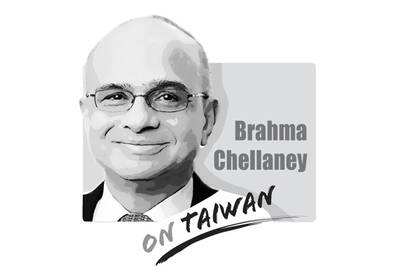When the US invaded Afghanistan in 2001, the global economy looked much different. Tesla was not a company, the iPhone did not exist and artificial intelligence was best known as a Steven Spielberg film.
Now all three are at the cutting edge of a modern economy driven by advancements in high-tech chips and high-capacity batteries that are made with a range of minerals, including rare earths.
Afghanistan is sitting on deposits estimated to be worth US$1 trillion or more, including what might be the world’s largest lithium reserves — if anyone can get them out of the ground.

Illustration: Kevin Sheu
Four decades of war — first with the Soviet Union, then between warring tribes, then with the US — prevented that from happening. That is not expected to change anytime soon, with the Taliban already showing signs they want to reimpose a theocracy that turns back the clock on women’s rights and other basic freedoms rather than lead Afghanistan to a prosperous future.
However, there is also an optimistic outlook, now being pushed by Beijing, that goes like this: The Taliban forms an “inclusive” government with warlords of competing ethnic groups, allows a minimal level of basic human rights for women and minorities, and fights terrorist elements that want to strike the US, China, India or any other country.
“With the US withdrawal, Beijing can offer what Kabul needs most: political impartiality and economic investment,” Zhou Bo (周波), who was a senior colonel in the People’s Liberation Army from 2003 to 2020, wrote in the New York Times on Friday last week. “Afghanistan in turn has what China most prizes: opportunities in infrastructure and industry building — areas in which China’s capabilities are arguably unmatched — and access to US$1 trillion in untapped mineral deposits.”
For that scenario to have even a remote possibility, much depends on what happens in the next few weeks. Although the US is racing to evacuate thousands of Americans and vulnerable Afghans after a rushed troop withdrawal ending 20 years of war, US President Joe Biden still has the power to isolate any new Taliban-led government on the world stage and stop most companies from doing business in the country.
In a statement on Tuesday, the G7 said the legitimacy of any Afghan government hinges on its adherence to international obligations, including ensuring human rights for women and minorities.
“We will judge the Afghan parties by their actions, not words,” the group said after a virtual leaders meeting.
The US maintains sanctions on the Taliban as an entity, and it can veto any moves by China and Russia to ease UN Security Council restrictions on the militant group. Washington has already frozen nearly US$9.5 billion in Afghanistan’s reserves, and the IMF has cut off financing for Afghanistan, including nearly US$500 million that was scheduled to be disbursed at the time when the Taliban took control.
To have any hope of accessing those funds, it is crucial for the Taliban to facilitate a smooth evacuation of foreigners and vulnerable Afghans, negotiate with warlords to prevent another civil war and halt a range of human rights abuses. Tensions are growing over an Aug. 31 deadline for troops to withdraw, with the Taliban warning the US not to cross what it called a “red line.”
Still, the Taliban has several reasons to exercise restraint. Kabul faces a growing economic crisis, with prices of staples such as flour and oil surging, pharmacies running short on drugs and ATMs depleted of cash. The militant group this week appointed a new central bank chief to address those problems, just as his exiled predecessor warned of shocks that could lead to a weaker currency, faster inflation and capital controls.
The Taliban also wants sanctions lifted, with spokesman Suhail Shahee telling China’s state-owned broadcaster CGTN this week that financial penalties would hurt efforts to rebuild the economy.
“The push for more sanctions will be a biased decision,” he said. “It will be against the will of the people of Afghanistan.”
Leaders of the militant group have said they want good international relations, particularly with China. Late on Tuesday, a Taliban spokesman wrote on Twitter that a senior official from the group met with the Chinese ambassador in Kabul and “discussed the security of the Chinese embassy and diplomats, the current situation in Afghanistan, bilateral relations and China’s humanitarian assistance.”
NOTHING LASTS FOREVER
Officials and state-run media in Beijing have softened the ground for closer ties, with the Beijing-backed Global Times reporting that Chinese investment is likely to be “widely accepted” in Afghanistan. Another report said that “the US is in no position to meddle with any potential cooperation between China and Afghanistan, including on rare earths.”
“Some people stress their distrust for the Afghan Taliban. We want to say that nothing is unchanged forever,” Chinese Ministry of Foreign Affairs spokeswoman Hua Chunying (華春瑩) said last week. “We need to see the past and present. We need to listen to words and watch actions.”
For China, Afghanistan holds economic and strategic value. Leaders in Beijing have repeatedly called on the Taliban to prevent terrorists from plotting attacks against China, and view strong economic ties as key to ensuring stability. They also see an opportunity to invest in the country’s mineral sector, which can then be transported back on Chinese-financed infrastructure, which includes about US$60 billion of projects in neighboring Pakistan.
US officials estimated in 2010 that Afghanistan had US$1 trillion of unexplored mineral deposits, and the Afghan government has said they are worth three times as much. They include vast reserves of lithium, rare earths and copper — materials critical to the global green-energy transition.
However, flimsy infrastructure in the landlocked country, along with poor security, have hampered efforts to mine and profit off the reserves.
The Taliban takeover comes at a critical time for the battery-materials supply chain. Producers are looking to invest in more upstream assets to secure lithium supply ahead of what Macquarie has called a “perpetual deficit.”
The US, Japan and Europe have been seeking to cut their dependence on China for rare earths, which are used in items such as permanent magnets, although the moves are expected to take years and require millions of dollars of government support.
One major problem for the Taliban is a lack of skilled policymakers, Former Afghan Ministry of Defense economic adviser Nematullah Bizhan said.
“In the past, they appointed unqualified people into key specialized positions, such as the finance ministry and central bank,” said Bizhan, who is now a lecturer in public policy at Australian National University. “If they do the same, that will have negative implications for the economy and for growth in Afghanistan.”
CHINA BURNED
Officially, Afghanistan’s economy has seen rapid growth in recent years, as billions in aid flooded the country. Yet that expansion has fluctuated with donor assistance, showing “how artificial and thus unsustainable the growth has been,” a report from the US Special Inspector General for Afghanistan Reconstruction said.
China has been burned before. In the mid-2000s, investors led by state-owned Metallurgical Corp of China won an almost US$3 billion bid to mine copper at Mes Aynak, near Kabul. It still has not seen any output due to a series of delays ranging from security concerns to the discovery of historical artifacts, and there is still no rail or power plant. The corporation said in its annual report last year that it was negotiating with the Afghan government about the mining contract after earlier saying it was economically unviable.
The Taliban is trying to show the world that it has changed from its oppressive rule in the 1990s, saying it welcomes foreign investment from all countries and will not allow terrorists to use Afghanistan as a base.
Janan Mosazai, a former Afghan ambassador to Pakistan and China who joined the private sector in 2018, sees “tremendous opportunities for the Afghan economy to take off” if the Taliban prove they are serious about “walking the talk.”
However, not many are optimistic. Reports have emerged of targeted killings, a massacre of ethnic minorities, violent suppression of protests and Taliban soldiers demanding to marry local women.
“Everyone is just in crisis mode,” said Sarah Wahedi, a 26-year-old tech entrepreneur from Afghanistan who fled the country. “I don’t see the entrepreneurs getting back to business unless there’s a huge overhaul in the Taliban’s behavior, and there’s nothing I’ve seen that makes me think that’s going to happen.”

China badly misread Japan. It sought to intimidate Tokyo into silence on Taiwan. Instead, it has achieved the opposite by hardening Japanese resolve. By trying to bludgeon a major power like Japan into accepting its “red lines” — above all on Taiwan — China laid bare the raw coercive logic of compellence now driving its foreign policy toward Asian states. From the Taiwan Strait and the East and South China Seas to the Himalayan frontier, Beijing has increasingly relied on economic warfare, diplomatic intimidation and military pressure to bend neighbors to its will. Confident in its growing power, China appeared to believe
Taiwan-India relations appear to have been put on the back burner this year, including on Taiwan’s side. Geopolitical pressures have compelled both countries to recalibrate their priorities, even as their core security challenges remain unchanged. However, what is striking is the visible decline in the attention India once received from Taiwan. The absence of the annual Diwali celebrations for the Indian community and the lack of a commemoration marking the 30-year anniversary of the representative offices, the India Taipei Association and the Taipei Economic and Cultural Center, speak volumes and raise serious questions about whether Taiwan still has a coherent India
Recent media reports have again warned that traditional Chinese medicine pharmacies are disappearing and might vanish altogether within the next 15 years. Yet viewed through the broader lens of social and economic change, the rise and fall — or transformation — of industries is rarely the result of a single factor, nor is it inherently negative. Taiwan itself offers a clear parallel. Once renowned globally for manufacturing, it is now best known for its high-tech industries. Along the way, some businesses successfully transformed, while others disappeared. These shifts, painful as they might be for those directly affected, have not necessarily harmed society
Legislators of the opposition parties, consisting of the Chinese Nationalist Party (KMT) and the Taiwan People’s Party (TPP), on Friday moved to initiate impeachment proceedings against President William Lai (賴清德). They accused Lai of undermining the nation’s constitutional order and democracy. For anyone who has been paying attention to the actions of the KMT and the TPP in the legislature since they gained a combined majority in February last year, pushing through constitutionally dubious legislation, defunding the Control Yuan and ensuring that the Constitutional Court is unable to operate properly, such an accusation borders the absurd. That they are basing this